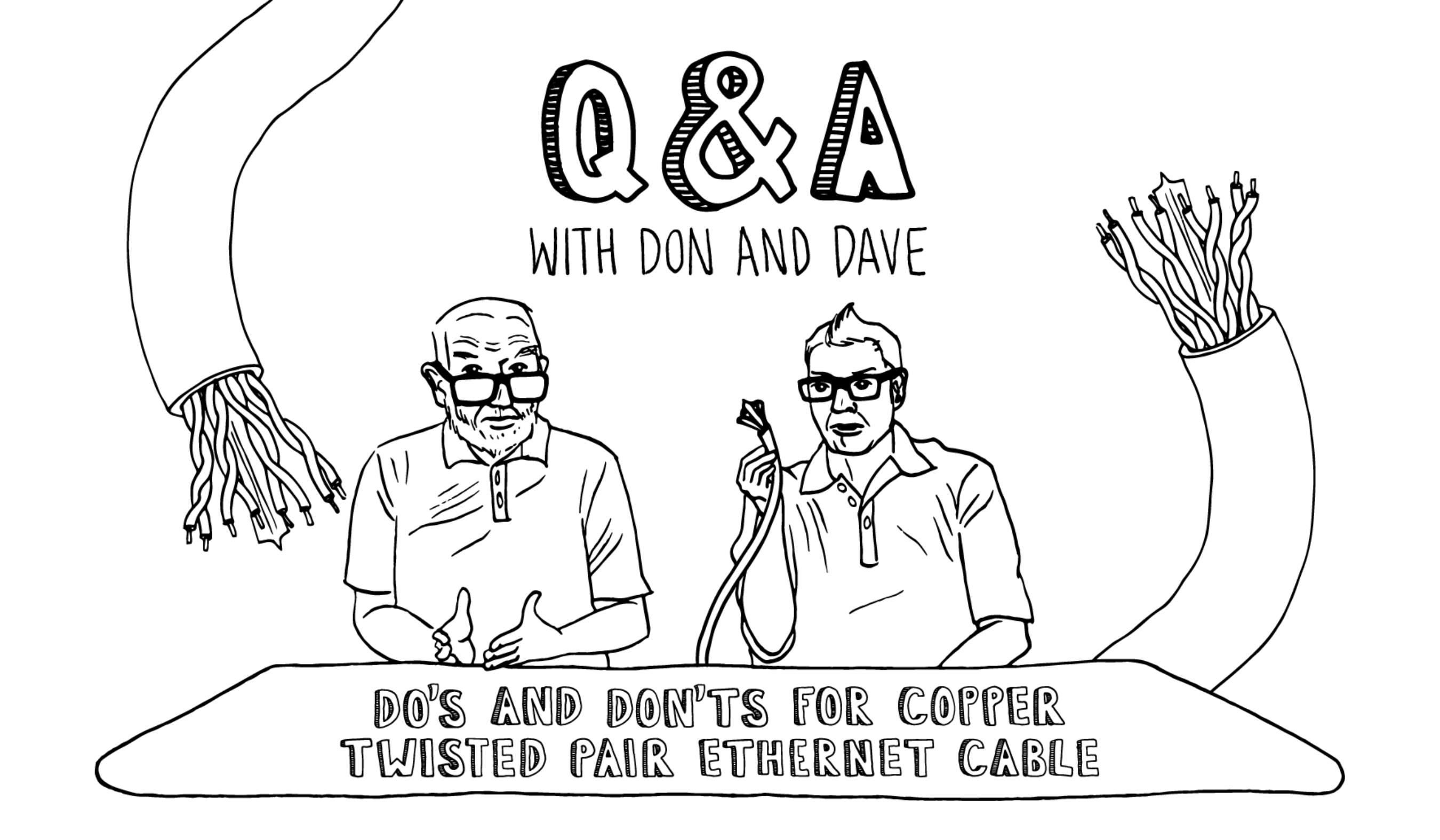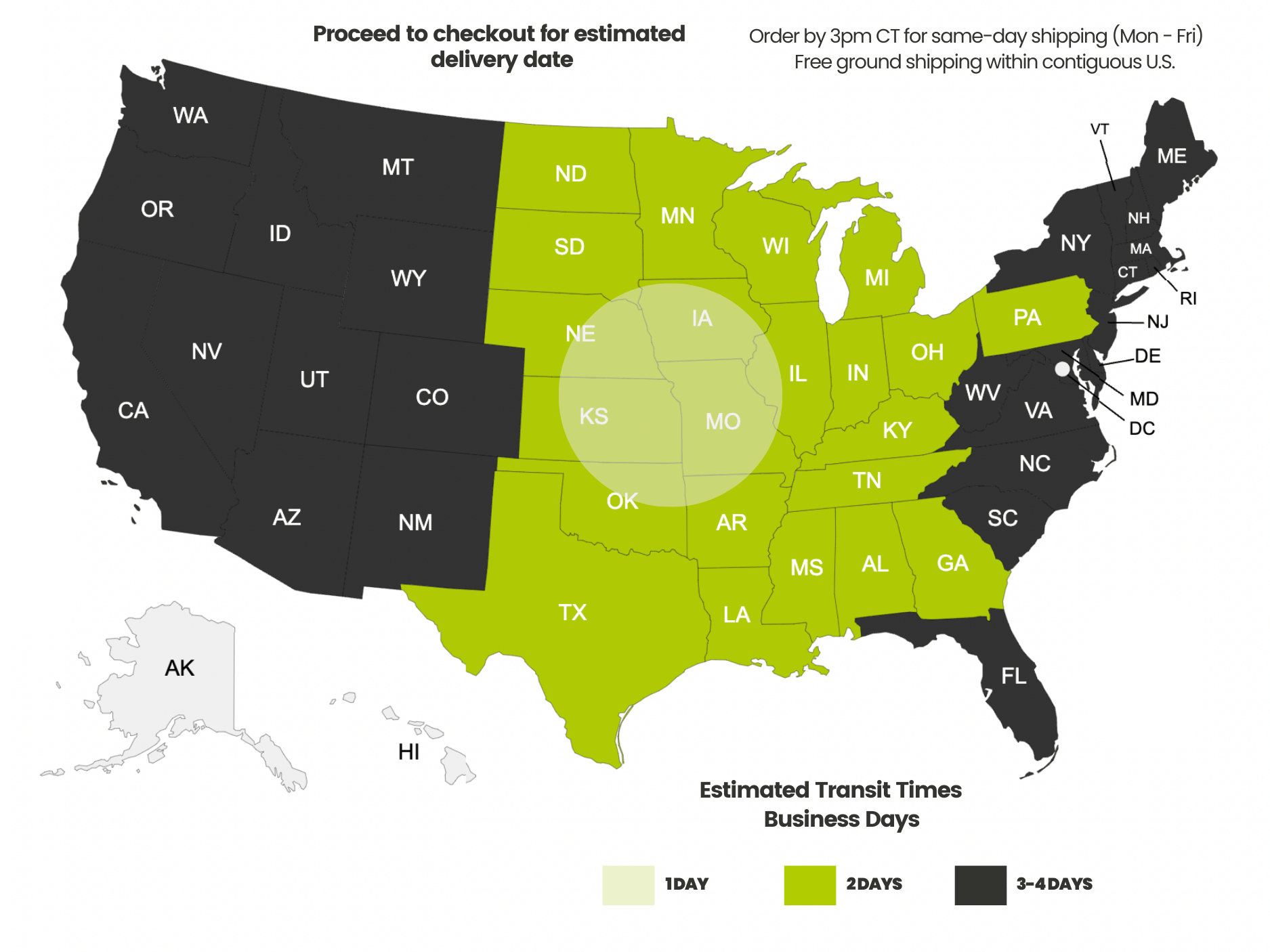Payment methods accepted

Q&A: Do's and Don'ts for Copper Twisted Pair Ethernet Cable with Don and Dave
And we're back with another Q&A video! This time, Don and Dave dive deep into copper twisted pair Ethernet cable. What are some best practices? What should you avoid? It's all up next in our latest Q&A edition.
Tune in below!
Don: Hey there, Youtubers! It's Don and Dave from trueCABLE, and today, we're coming back to you with some tips and tricks (primarily some don'ts) revolving around copper twisted pair Ethernet cable. And there's quite a few do’s and there's quite a few don'ts, but you should probably know about the don’ts for sure. So, Dave will be taking a few and I'll be taking a few, and hopefully you'll find this useful for your installations.
Don't Do: Kinking Your Ethernet Cable
You're putting in your Ethernet cable, and you've got a tight turn, and you might be tempted to do something like this, which is literally turn a right corner with your Ethernet cable. That is a really, really bad idea. Your cable should never look like this, okay? There is a bend radius that is associated with every kind of Ethernet cable that you can install, and typically, for unshielded cable, it's four times the outside diameter. That's the radius. If you bend it into a circle, it'll be times two for the diameter. And with shielded cable, it's going to be (generically speaking) eight times the outside diameter for the radius, multiply times two for the diameter. So, be careful not to put a nice kink in your cable because that can cause a great deal of problems inside the cable and cause bad data packets or even a non-working cable. And so that's the first one out of the way. Dave, you're up next.
Don't Do: Pulling Ethernet Cable Too Hard
Dave: Don't use your cable in a tractor pulling contest and expect it to work afterwards. Well, actually, at your tractor pulling contest, if you're using your data cable to transmit data, it's probably okay. If you're using it to pull a tractor, or to pull a tractor payload, yeah, it's going to snap like a string. The main point of this exercise here, though, is: don't stretch the cable. Don't pull it too hard. If you pull it with a tractor, it would be way too hard. The Ethernet cable is different from other types of electrical cable in that it's not just constructed to transmit power. It is an engineered system to transmit data efficiently. And that's a whole different thing. The twisted pair system has four of these twisted pairs of cables. And they're twisted at a certain rate. The two wires are encircling each other, or going around each other, in such a way that the electrical fields that they are producing cancel each other out. Also the actual current that's flowing down these wires is traveling at different phases. So that the signal is actually different in what comes through these 2 wires. Point is, if you pull this thing and stretch it, that changes the data transmission characteristics of the system. So, there's a limit. 110 newtons is the largest amount of force you can put on the cable. Another place where stretching the cable comes into play. When I was first shown how to terminate one of these cables, it was at a major national data center, and they actually told me to wrap this around my finger and yank it out. And it was fast and it was good. I'm not going do that to my finger today, but it actually looks something like this.
It turns out this was a really bad idea. First of all, it makes it real hard to terminate because you're left with a little end here. But also, the method stretches that inner spline out, and we don't know how far it's been stretched out or to what extent. That changes the data transmission characteristics of the cable. So, don't stretch the cable or pull it hard. Use lubricant in your conduit and protect your system.
Don: If you ever really want to know, though, just go buy a meter that is basically a pole gauge and attach it to something hard. Like, one end of it. Attach a cable, an Ethernet cable, to the other side of it and pull until it reads 25 foot pounds. You're going to know what that feels like, but also be careful with yanking because you can easily get to that 25 foot pounds without that.
Don't Do: Untwisting Ethernet Cable Too Much
Don: The distance from the end of the cable jacket to the golden contacts is one half inch maximum, so that should never exceed one half inch. If you get it closer to the golden contacts, that's fine. Sometimes you can't physically get it closer than half an inch, but you definitely don't want that space that you're seeing in that connector to get any larger than that from the end of the cable jacket to the golden contacts. In the case of a keystone jack, when you bring the end of the cable to the rear of the jack, two pairs are going to go into the rear two slots of the keystone. It's okay to untwist those all the way down because if you were to untwist them down to the jacket and thread them into the rear slots on the jack, on the IDC terminals, as they're called, you're not going to be over half an inch. The two pairs that are going towards the front of the jack, that being the green and the blue, those you only want to untwist as much as necessary to get them threaded into the IDC terminals. So if you lay the pair directly across the IDC terminal, you're able to visualize whether or not you will have to go just one untwist past the point of the terminal. In other words, when you lay that pair on it, you'll be able to tell if you're able to just untwist a little bit to seat the two, you know, the pair, or if you are going to have to go one untwist past the pair, but just one more untwist past is as much as you want to go. The reason is because as soon as you untwist the pairs excessively, then what happens is crosstalk at the connector starts getting out of control, and that will damage your data transmission. You'll end up with a poorly performing run or a non-working run altogether. So that's that one, and Dave's a go for the next one.
Don't Do: Making Your Own Patch Cords
Dave: In case you don't know, the patch cable is an Ethernet cable that has an RJ45 plug on each end, and it's made to make the final connection to your device from say a wall plug or a switch. Or it's used to make a connection between a switch and a patch panel. The purpose of a patch cable is to make that final connection, but to be able to make that connection over and over and over again. And so a patch cable is made out of flexible stranded copper cable. That's not the kind of cable that we sell for construction purposes. We sell cable that is meant to be part of the infrastructure of your building and it's not meant to move once it's installed. Taking that cable and bending it and using and reusing it and unplugging and replugging… it will soon cause it to bend and kink and change its data transmission characteristics.
So, why don't you just make your own patch cable out of flexible cable? Go buy some flexible cable and some ends and make your own? Well, the patch cables have to be tested to a very high standard because in the field the testing that goes on is what's called permanent link testing… testing between the jack and the patch panel. And in order to avoid situations where a patch cable is going to introduce too much data compromisation, they’re tested to a very high standard, and so you should buy factory-built patch cables and avoid making your own.
Don: When you’re installing solid copper Ethernet, it's just a sanity saver to buy the pre-made factory-made patch cords. They're flexible. They've already been pre-tested. The patch cords that trueCABLE is going to be introducing will be factory-certified before each one 100%. It's nice to know that patch cable's already working.
It's when you're putting eight 8P8C RJ45 connectors onto a patch cord that (especially solid copper Ethernet cable) that that can start causing a lot of unintended consequences and difficulties. So, just for your own sanity, rack to jack is the most reliable way, which is keystone to patch panel and then just use pre-made patch cords. That's how the professionals do it.
Don't Do: Running Cable Around High-Voltage Motors or High-Power Electrical Cable
Don: So, it doesn't make any sense for you to run Ethernet cable (shielded or unshielded) and wrap it around your nearest electrical motor, okay? So, a 480V DC electrical motor. That's a bad idea. Even though the shielding may protect it, it's still a really bad idea.
So, distance is your friend when it comes to electromagnetic interference, whether that's your motors or transformers or powered equipment or AC or like Romex cable in your walls… if we're talking about a reasonable voltage like 240 volts or less, mostly that covers everything residential and a lot of commercial… basically, I would skip from one wall bay to the next wall bay with unshielded, and if it's necessary, you can get within a couple of inches on parallel with electrical inside of a wall.
But generally speaking, you should keep your distance as best you can just to minimize any problems because with Ethernet cables carrying data at higher frequencies, EMI is going to start to have a greater impact on Ethernet cable that gets too close to EMI sources. So, now when it comes to running Ethernet to electrical at a right angle like this… let's say you've got an electrical wire going this way and you've got your Ethernet cable going this way, that's a right angle… as long as you're not touching physically, that's fine to do. But it's when you start running them on parallel that one can interfere with another and it's usually not a safety problem. But in extreme cases it can be, but it's more of a data transmission problem. So, maintain your distance. But don't use shielded willy-nilly either just to try to get closer or defeat it or because you think shielded is faster. Shielded is actually for situations where you just don't really have any alternative. So distance is your best friend when it comes to that sort of thing, all right? Dave, on to you.
Don't Do: Bringing Outdoor Cable Over 50ft. Inside Prior to Termination (In a Commercial Business)
Dave: Outdoor cable is not fire-rated. What that means is that when it burns, the combustion products are not compatible with human survival. So you don't want this stuff in your building under any circumstances. Now, you're allowed 50 feet because you're probably going to have multiple outdoor circuits that have to come into the building in order to be terminated, so 50 feet is that limit. And that's true also for residential installations. But there is an exception for residential. If the outdoor cable coming into the building is lower in diameter than one quarter inch, then it can be run inside a residence. And by residence, I'm pretty sure we mean a single-family or two-family structure.
Lower than a quarter inch in diameter and your outdoor cable can be used inside in a residential setting. trueCABLE does offer a Cat6 outdoor unshielded cable that does fit this exemption.
Don't Do: Cutting Too Deep Into the Cable When Stripping It
Don: It is really important that you do not accidentally knick conductors that are on the inside of the cable and that's very easy to do with those self-adjusting, springy type cable strippers. We have a cut and strip tool that we sell at trueCABLE that has an adjustable wheel on the top, which allows you to adjust for the strip depth that's necessary to achieve the Ethernet cable. So, I'm just going to use a piece of scrap cable here to demonstrate. You put the cable in like so. You let the handle down and you adjust the wheel. So, the stripper is making good contact with the top of the cable. You turn one time. Take it off. And then what you're going to have is a nice score on the cable jacket. I'm going to break it at the score and the jacket will pull away.
If you ever wonder if you did nick a conductor, there's an easy way to check. What you do is you check at the cable jacket edge with the conductors and you inspect to make sure that you don't see any slices or glimpse of copper all the way around and you can check it all the way around like I'm doing right now. And I'm not seeing any slices or any hints of copper, and that's how you make sure you don't nick a conductor. Nicking conductors when you're terminating Ethernet is one of the most common ways (outside of too tight of a bend or pulling too hard) to damage Ethernet cable. And if you do nick a conductor, you're going to affect the performance of your cable to the point where you don’t get the speeds that you are expecting.
So that is pretty much the don'ts and some do’s for this particular session. I hope you found this useful for installing your next Ethernet cable project, and if you would subscribe to our channel, it'd be great. Leave us a thumbs up or a thumbs down as you see fit and leave a comment below if you have some tips or tricks of your own. We'd love to hear them. We might even do a video on them… you never know! So, anyway, with that, I'm going to say you all have a great day. Thanks for tuning in and listening to Dave and I.
Happy networking!
trueCABLE presents the information on our website, including the “Cable Academy” blog and live chat support, as a service to our customers and other visitors to our website subject to our website terms and conditions. While the information on this website is about data networking and electrical issues, it is not professional advice and any reliance on such material is at your own risk.



























